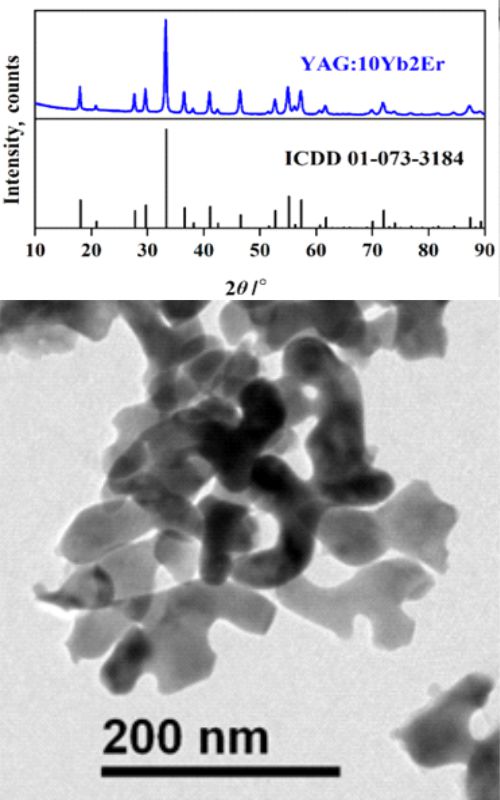Odnos intenziteta luminescencije tri termalizovana nivoa u YAG:Er3+/Yb3+nanočesticama Naučni rad
Glavni sadržaj članka
Apstrakt
Luminiscentna termometrija je metoda za očitavanje temperature pomoću daljinskog senzora temperature posmatranjem temperaturno zavisnih spektralnih promena. Potraga za povećanom osetljivosti očitavanja temperature motivisala je istraživanje korišćenja trećeg termalizovanog nivoa Er3+ emisije u fotoluminiscenciji Yb3+/Er3+. Za ovu svrhu pripremljene su veoma stabilne i efikasne nanočestice YAG:Yb3+/Er3+ modifikovanom Pećinijevom metodom. Emisioni spektri su snimljeni u temperaturnom opsegu od 300 K do 800 K i dobijena su dva odnosa intenziteta luminiscencije između emisija 4S3/2, 2H11/2 i 4F7/2. Pored odličnog poklapanja sa teorijskim predviđanjima, očitavanje korišćenjem 4F7/2 metode je omogućilo 3,5 puta povećanje relativne osetljivosti u odnosu na odnos intenziteta luminiscencije za nivo 2H11/2, uz ograničenje upotrebljivosti samo iznad 600 K. Metoda emisije iz 2H11/2 treba da se koristi od 300 K do 600 K, dok emisija od 4F7/2 obezbeđuje najbolji odnos intenziteta luminiscencije od 600 K do 800 K. YAG:Yb3+/Er3+ nanočestice su se pokazale kao odličan senzorski materijal za luminescentnu metodu odnosa intenziteta korišćenjem više termalizovanih nivoa.
Detalji članka
Broj časopisa
Rubrika

Ovaj rad je pod Creative Commons Aуторство-Nekomercijalno-Bez prerade 4.0 Internacionalna licenca.
Kada je rukopis prihvaćen za objavlјivanje, autori prenose autorska prava na izdavača. U slučaju da rukopis ne bude prihvaćen za štampu u časopisu, autori zadržavaju sva prava.
Na izdavača se prenose sledeća prava na rukopis, uklјučujući i dodatne materijale, i sve delove, izvode ili elemente rukopisa:
- pravo da reprodukuje i distribuira rukopis u štampanom obliku, uklјučujući i štampanje na zahtev;
- pravo na štampanje probnih primeraka, reprint i specijalnih izdanja rukopisa;
- pravo da rukopis prevede na druge jezike;
- pravo da rukopis reprodukuje koristeći fotomehanička ili slična sredstva, uklјučujući, ali ne ograničavajući se na fotokopiranje, i pravo da distribuira ove kopije;
- pravo da rukopis reprodukuje i distribuira elektronski ili optički koristeći sve nosioce podataka ili medija za pohranjivanje, a naročito u mašinski čitlјivoj/digitalizovanoj formi na nosačima podataka kao što su hard disk, CD-ROM, DVD, Blu-ray Disc (BD), mini disk, trake sa podacima, i pravo da reprodukuje i distribuira rukopis sa tih prenosnika podataka;
- pravo da sačuva rukopis u bazama podataka, uklјučujući i onlajn baze podataka, kao i pravo prenosa rukopisa u svim tehničkim sistemima i režimima;
- pravo da rukopis učini dostupnim javnosti ili zatvorenim grupama korisnika na osnovu pojedinačnih zahteva za upotrebu na monitoru ili drugim čitačima (uklјučujući i čitače elektonskih knjiga), i u štampanoj formi za korisnike, bilo putem interneta, onlajn servisa, ili putem internih ili eksternih mreža.
Kako citirati
Funding data
-
Ministarstvo Prosvete, Nauke i Tehnološkog Razvoja
Grant numbers 451-03-47/2023-01/200017
Reference
[1] Wang X, Wolfbeis OS, Meier RJ. Luminescent probes and sensors for temperature. Chem Soc Rev. 2013; 42(19): 7834. https://doi.org/10.1039/c3cs60102a
[2] Wade SA. Temperature Measurement Using Rare Earth Doped Fibre Fluorescence. Victoria. 1999:169. https://vuir.vu.edu.au/id/eprint/15723
[3] Wade SA, Collins SF, Baxter GW. Fluorescence intensity ratio technique for optical fiber point temperature sensing. J Appl Phys. 2003; 94(8):.743. https://doi.org/10.1063/1.1606526
[4] Wang X, Liu Q, Bu Y, Liu C-S, Liu T, Yan X. Optical temperature sensing of rare-earth ion doped phosphors. RSC Adv. 2015; 5(105): 86219–36. https://doi.org/10.1039/C5RA16986K
[5] Sun Q-C, Ding YC, Sagar DM, Nagpal P. Photon upconversion towards applications in energy conversion and bioimaging. Prog Surf Sci. 2017; 92(4): 281–316. https://doi.org/10.1016/j.progsurf.2017.09.003
[6] Auzel F. Compteur quantique par transfert d’energie entre deux ions de terres rares dans un tungstate mixte et dans un verre. CR Acad Sci Paris. 1966; 262: 1016–1019.
[7] Suta M, Meijerink A. A Theoretical Framework for Ratiometric Single Ion Luminescent Thermometers—Thermodynamic and Kinetic Guidelines for Optimized Performance. Adv Theory Simulations. 2020; 3(12): 2000176. https://doi.org/10.1002/adts.202000176
[8] Marciniak L, Bednarkiewicz A, Kowalska D, Strek W. A new generation of highly sensitive luminescent thermometers operating in the optical window of biological tissues. J Mater Chem C. 2016; 4(24): 5559–5563. https://doi.org/10.1039/C6TC01484D
[9] Ćirić A, Periša J, Zeković I, Antić Ž, Dramićanin MD. Multilevel-cascade intensity ratio temperature read-out of Dy3+ luminescence thermometers. J Lumin. 2022 ;245: 118795. https://doi.org/10.1016/j.jlumin.2022.118795
[10] Ćirić A, Aleksić J, Barudžija T, Antić Ž, Đorđević V, Medić M, Periša J, Zeković I, Mitrić M, Dramićanin MD. Comparison of three ratiometric temperature readings from the Er3+ upconversion emission. Nanomaterials. 2020; 10(4): 627. https://doi.org/10.3390/nano10040627
[11] Shi H, Zhu C, Huang J, Chen J, Chen D, Wang W, Wang F, Cao Y, Yuan X. Luminescence properties of YAG:Ce, Gd phosphors synthesized under vacuum condition and their white LED performances. Optical Materials Express. 2014; 4 (4): 649-655. https://doi.org/10.1364/OME.4.000649
[12] Pechini M. Method of preparing lead and alkaline earth titanates and niobates and coating method using the same to form a capacitor. US Patent No. 3330697., 1967
[13] Periša J, Ristić Z, Piotrowski W, Antić Ž, Marciniak L, Dramićanin MD. All near-infrared multiparametric luminescence thermometry using Er3+, Yb3+-doped YAG nanoparticles. RSC Advances. 2021; 11(26): 15933. https://doi.org/10.1039/d1ra01647d
[14] Yin HJ, Feng JS, Liang N, Liu XM, Liu JX, Wang KZ, Yao CJ. Boosting Photo Upconversion in Electropolymerised Thin Film with Yb/Er Complexes. Adv. Opt. Mat. 2023; 11(6), 2202550. https://doi.org/10.1002/adom.202202550
[15] Yoshikawa A, Boulon G, Laversenne L, Canibano H, Lebbou K, Collombet A, Guyot Y, Fukuda T. Growth and spectroscopic analysis of Yb3+-doped Y3Al5O12 fiber single crystals. J Appl Phys. 2003; 94(9): 5479–88. https://doi.org/10.1063/1.1597763
[16] Ćirić A, van Swieten T, Periša J, Meijerink A, Dramićanin MD. Twofold increase in the sensitivity of Er3+/Yb3+ Boltzmann thermometer. J Appl Phys. 2023; 133(19): 194501 https://doi.org/10.1063/5.0149757
[17] Auzel F. Upconversion and Anti-Stokes Processes with f and d Ions in Solids. Chem Rev. 2004; 104(1): 139-174. https://doi.org/10.1021/cr020357g
[18] Ćirić A, Dramićanin MD. LumTHools - Software for fitting the temperature dependence of luminescence emission intensity, lifetime, bandshift, and bandwidth and luminescence thermometry and review of the theoretical models. J Lumin. 2022; 252: 119413. https://doi.org/10.1016/j.jlumin.2022.119413
[19] Ćirić A, Gavrilović T, Dramićanin MD. Luminescence Intensity Ratio Thermometry with Er3+. Crystals. 2021; 11(2): 189. https://doi.org/10.3390/cryst11020189





